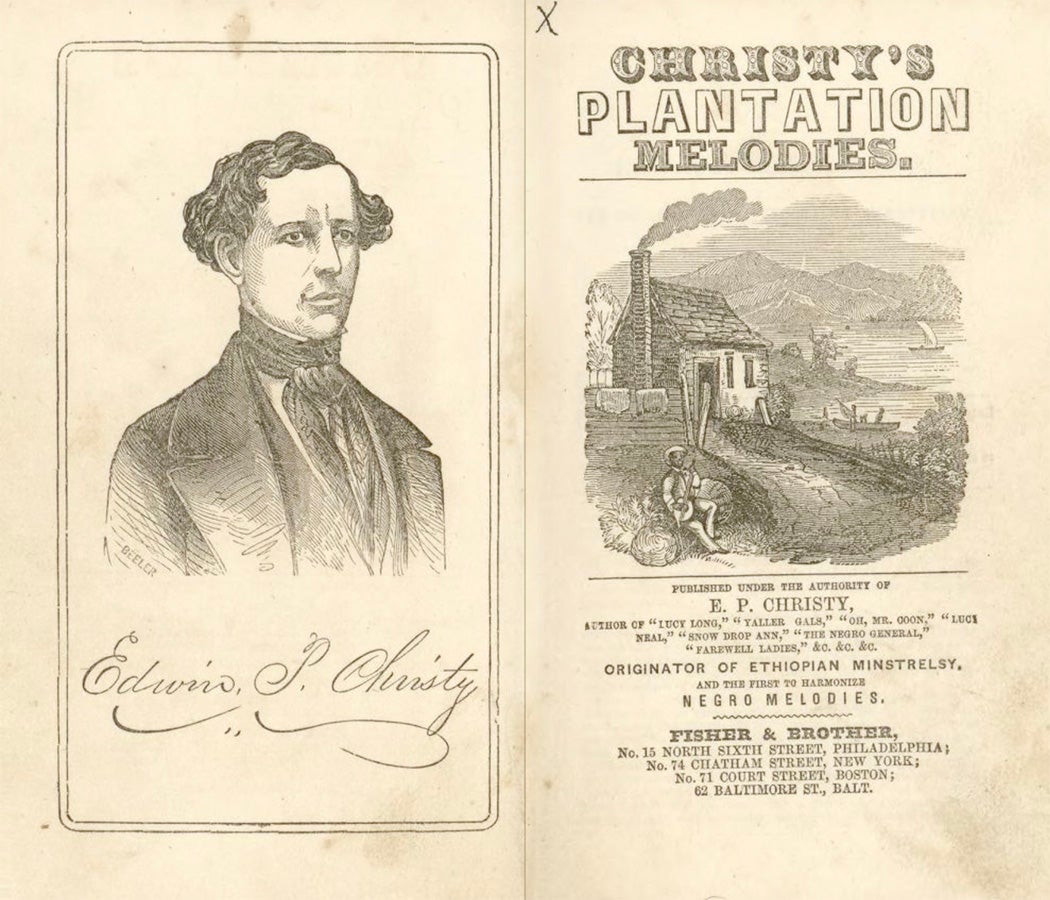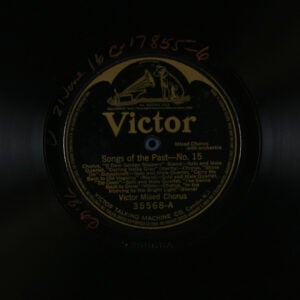The icon indicates free access to the linked research on JSTOR.
Despite being closely associated with American entertainment, blackface minstrelsy was also internationally popular for decades during the nineteenth century. In the summer of 1857, the well-known Christy’s Minstrels troupe traveled to England, and at least in Britain folks had reason to suspect that such spectacles might have—must have, really? —run their course. In the July 29 issue of London’s Morning Chronicle, a reporter wondered, since Christy’s music was well performed as is, “is it supposed that the Minstrels will render them more agreeable to a West-end company by blackening their faces?”
The answer was, well, yes. The Morning Post, on December 28, concluded that the “prestige” of the show “has been well deserved [as] is evinced by the numbers who nightly crowd the Polygraphic Hall, King William-street.” Christy’s 1857 tour and subsequent presence in the United Kingdom is indicative of the strange and enduring overseas popularity of minstrel shows, which allowed imperial societies to musically litigate matters of identity.

Minstrel shows had been part of American entertainment since at least the 1830s, when a handful of men decided to make musical variety entertainment out of supposed Black rudiments. A typical minstrel show presented white performers in burnt-cork blackface, performing music, dance, and variety acts through exaggerated racial caricature. Many of the musicians and actors involved had been unsuccessful at making a living in traditional performance and saw a new gimmick. Edwin P. Christy, of the aforementioned traveling Minstrels, had rebelled against a career in accountancy to join the circus. As he reported in Christy’s Plantation Melodies (1854), a collection of lyrics popularly known as a “songster,” he conceived his “glorious plan” of performing blackface shows in 1841; his group was touring upstate New York by 1842.

Songs of the past, no. 15 / Victor Mixed Chorus
Audio Player
Minstrelsy was complex and problematic from the start, and it was presented and received differently across time and geography. The historian and novelist Alexander Saxton notes the clear problems of appropriation and mutation that were inherent to the form. The work of white entertainers, he argues, was to take Black sources and “Europeanize them sufficiently so that they would not offend refined ears. Thus the dual task of exploiting and suppressing African elements began from the first moments of minstrelsy.”
In the preface to Christy’s Plantation Melodies, Christy explains that minstrel troupes served as evidence of American cultural independence:
After our countrymen had, by the force of native genius in arts, arms, science, philosophy and poetry, &c., &c., confuted the stale cant of our European detractors that nothing original could emanate from Americans—the next cry was, that we had no NATIVE MUSIC; which exclamation was tauntingly reiterated, until our countrymen found a triumphant, vindicating APOLLO in the genius of E. P. CHRISTY, who…was the first to catch our native airs as they floated wildly, or hummed in the balmy breezes of the sunny south… [emphases in original]
Some audiences believed that minstrelsy authentically represented plantation culture or Black life (it did not). Others considered “Jump Jim Crow” and other exaggerated stock minstrel routines as derivative of English jigs and traditional music, with a manufactured racial overlay. Commentators including W. E. B. Du Bois and Margaret Fuller considered minstrelsy proof that Black music was the only “real” American art form—DuBois thought that Stephen Foster had consciously appropriated Black music, and Fuller viewed Black art with condescension as something like “the folk culture of an American peasantry,” writes literary scholar Eric Lott. By and large, white performers were comfortable taking from Black culture to socially construct their own racial superiority and then styling the effort as a gesture of honor.
American minstrelsy went overseas soon after its invention. And if critics considered that the shows would have less appeal or relevance outside their original political context, they were mistaken. When American minstrelsy traveled abroad, it became clear that it wasn’t just about a single political context; it was also about helping mainstream white audiences situate themselves in relation to a feared or subordinate “other.”
According to Richard Waterhouse, minstrelsy found a market in the United Kingdom and Australia for some of the same reasons that it did in the United States. With urbanization and a growing entertainment industry, “the traditional rural pastimes were irrelevant both to the values and the rhythm of the modern city.” Western Victorian ideology linked status and respectability to order, morality, and hard work. In contrast,
the minstrel stage Negro was lazy, self-indulgent, foolish and undisciplined. The minstrel show was therefore a place where the new urban classes, caught up in an unprecedently competitive environment, went both to release and define themselves.
In the United States, minstrelsy was a pressing and immediate comment on enslavement, culture, and the Black body. Britain, though, had abolished slavery and had no specific relationship to Black American populations.
What Britain did have, however, was an empire, and blackface was a medium that let audiences reinforce their own roles therein. Theater and performance scholar Tracy C. Davis entertains the idea that while Christy’s overseas tour may have actually been a way to promulgate anti-slavery concepts—she notes that “the repertoire of Christy’s Minstrels referred to slavery…more often than their competitors and had twice as many lyrics (4 out of 50) than their contemporaries that critiqued slavery in a recognizable form”—this concept didn’t necessarily resonate with audiences. The popularity of minstrel shows in England implicates colonialism and the related belief that Britain was providing West Indian, African, and South Asian populations with civilization and order.
“The popularity of the minstrel show,” writes Waterhouse, confirms “that these were attitudes and assumptions shared not only by those who had acquired and maintained the Empire but by the rest of the population as well.” Black stage characters become a proxy for “all groups lacking in Anglo-Saxon character” and in need of civilizing influence.
Weekly Newsletter
It was a flexible form. Saxton argues that, taken as a whole, “the genre provided a kind of underground theater where the blackface ‘convention’ rendered permissible topics which would have been taboo on the legitimate stage or in the press.”
Only a few decades before the arrival of the Christy Minstrels in the United Kingdom, the British public had celebrated Saartjie (Sarah) Baartman, an indigenous African woman exhibited as the “Hottentot Venus” for paying crowds. As Davis writes, in the same way that Baartman’s exhibition as a “beauty” allowed Britons to engage with coarse sexuality and physical Blackness without disturbing their respectability, blackface minstrelsy allowed audiences “to be very un-British without disturbing their sense of self and Britishness.”
Support JSTOR Daily! Join our membership program on Patreon today.

Resources
JSTOR is a digital library for scholars, researchers, and students. JSTOR Daily readers can access the original research behind our articles for free on JSTOR.
Blockson Pamphlets, Temple University
New York: H. Long & Brother, c. 1850
By: Alexander Saxton
American Quarterly, Vol. 27, No. 1 (March 1975), pp. 3–28
The Johns Hopkins University Press
By: I. H.
Lithograph, Open: Wellcome Collection
S. W. Fores, c. 1837
The Musical Times and Singing Class Circular, Vol. 21, No. 451 (September 1, 1880), pp. 441–442
Musical Times Publications Ltd.
By: Stephen Collins Foster
Goucher College Printed Music Collection, Goucher College
Firth, Pond & Co., 1852
By: Eric Lott
American Quarterly, Vol. 43, No. 2 (June 1991), pp. 223–254
The Johns Hopkins University Press
By: Richard Waterhouse
Australasian Journal of American Studies, Vol. 4, No. 1 (July, 1985), pp. 1–11
Australia New Zealand American Studies Association
By: Tracy C. Davis
TDR (1988–), Vol. 57, No. 2, Routes of Blackface: Special Issue (Summer 2013), pp. 38–65
Cambridge University Press; The MIT Press
By: Chinua Thelwell
TDR (1988–), Vol. 57, No. 2, Routes of Blackface: Special Issue (Summer 2013), pp. 66–85
Cambridge University Press; The MIT Press
By: ALISON E. WRIGHT
Burning Bright: Essays in Honour of David Bindman, Eds. Diana Dethloff, Tessa Murdoch, Kim Sloan, and Caroline Elam, (2015), pp. 115–25
UCL Press